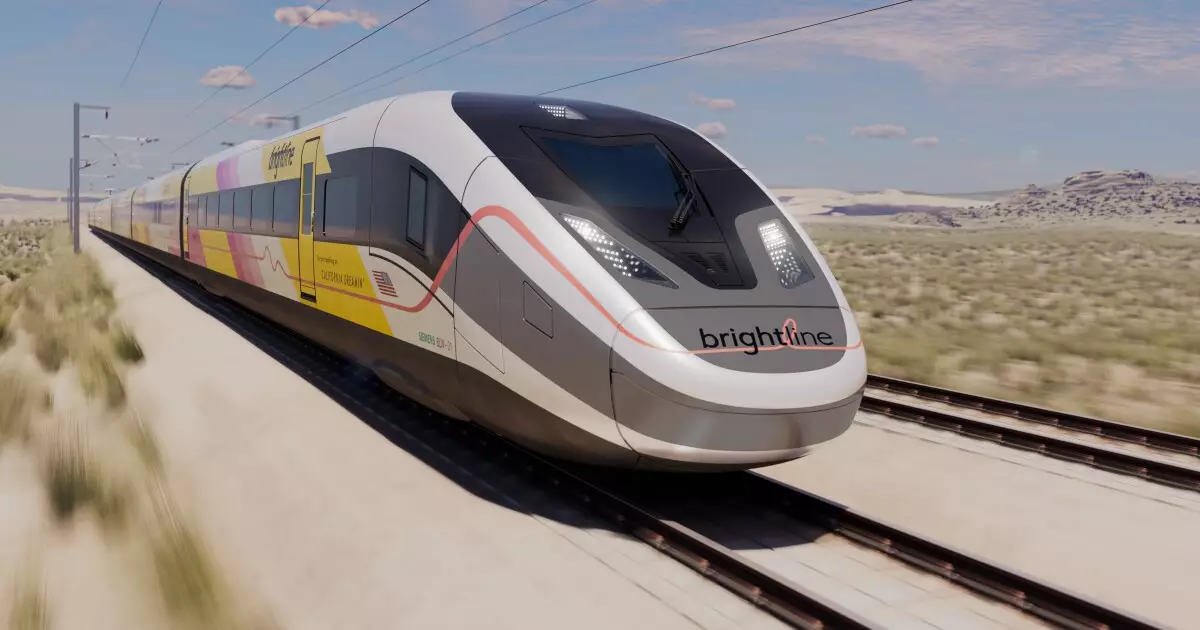Brightline West has emerged on the financial landscape with a bold plan to connect Las Vegas and Los Angeles through a bullet train. This initiative signifies more than just a transportation option; it aims to revolutionize travel between two of the West’s busiest urban hubs. The recent issuance of $2.5 billion in unrated private activity bonds represents what could become one of the largest high-yield municipal borrowing activities of the year. Investors and stakeholders are closely monitoring this development as it not only highlights the growing enthusiasm for high-speed rail in the United States but also presents unique investment opportunities.
The overwhelming response from investors to Brightline West’s bond issuance is noteworthy. Over $3.4 billion in orders flooded in for a $2.5 billion offering, driven by a diverse array of 75 participating accounts. This remarkable demand underscores the attractiveness of the deal, which features bonds offering a substantial yield and a strong liquidity profile. The ability to structure the bonds in a singular $2 billion CUSIP is particularly rare in the municipal bond market, but investors have recognized this structural innovation as a means to enhance liquidity and marketability, providing assurance in a field often fraught with complexity.
Jim Lyman from Belle Haven Investments, which participated in the deal, emphasized that investors are not just acquiring high-yield bonds; they are investing in a project with solid economic potential. The bonds’ 9.5% coupons, priced at a discount, and their callable premium nature enhance their overall appeal, creating an investment proposition that many found impossible to overlook. This sentiment is further reflected in the remarks of a high-yield portfolio manager, who highlighted the combination of yield performance, government support, and project excitement as distinctly advantageous.
The financing process for Brightline West is not without challenges. The issuance of $2.5 billion in bonds is merely the first step in addressing the full estimated cost of $12.4 billion for the train project. The company now has a critical 180-day window to secure a $6 billion bank facility, which is intended to be senior to the private activity bonds already issued. This facility may also include a tax-exempt tranche, adding layers of financial complexity to the project. Failure to secure this funding will trigger mandatory bond redemption provisions, which could have severe implications for the investment community.
Brightline West is charting a course with an eye on both immediate financing needs and long-term operational vision. The construction timeline aims for a completion date of December 2028, which, despite extending beyond the previous target aligned with the Los Angeles Olympics, establishes a clear operational commitment. As discussions continue with multiple stakeholders, the financing strategy must adapt to ensure clarity and confidence among investors.
Recent political developments have cast a spotlight on Brightline West, adding layers of intrigue to its financing endeavors. The Trump administration’s public criticism of California’s high-speed rail progress contrasts sharply with its support for Brightline West. The federal government’s potential rescindment of $4 billion allocated for the California project has raised eyebrows and sparked concern among investors, particularly regarding the broader landscape of federal transportation grants.
Brightline West has secured a $3 billion federal grant from the Biden administration, a pivotal aspect of its financing strategy. Given the intertwining of political support and funding, potential investors view these developments as double-edged swords. Stakeholders must evaluate the long-term viability of Brightline West against the backdrop of a politically charged atmosphere which can influence federal funding and support.
As Brightline West prepares for the next steps in its ambitious project, the road ahead is filled with both promise and uncertainty. The company’s partnership with Fortress Investment Group adds credibility to the venture, yet investor skepticism remains concerning ridership projections and economic dynamics. The financing team remains active in reassuring potential investors by updating bond documents and clarifying funding structures.
Ultimately, Brightline West represents a pivotal shift in the landscape of American high-speed rail. If successful, it could not only change the way people travel between Las Vegas and Los Angeles but also pave the way for more such projects nationwide. As the timeline for construction begins, the investment community will be keenly observing the unfolding strategies and how effectively the project can navigate the complexities of political sentiment, capital requirements, and market dynamics. The intentions are clear — transform rail travel in America, one bond at a time.

